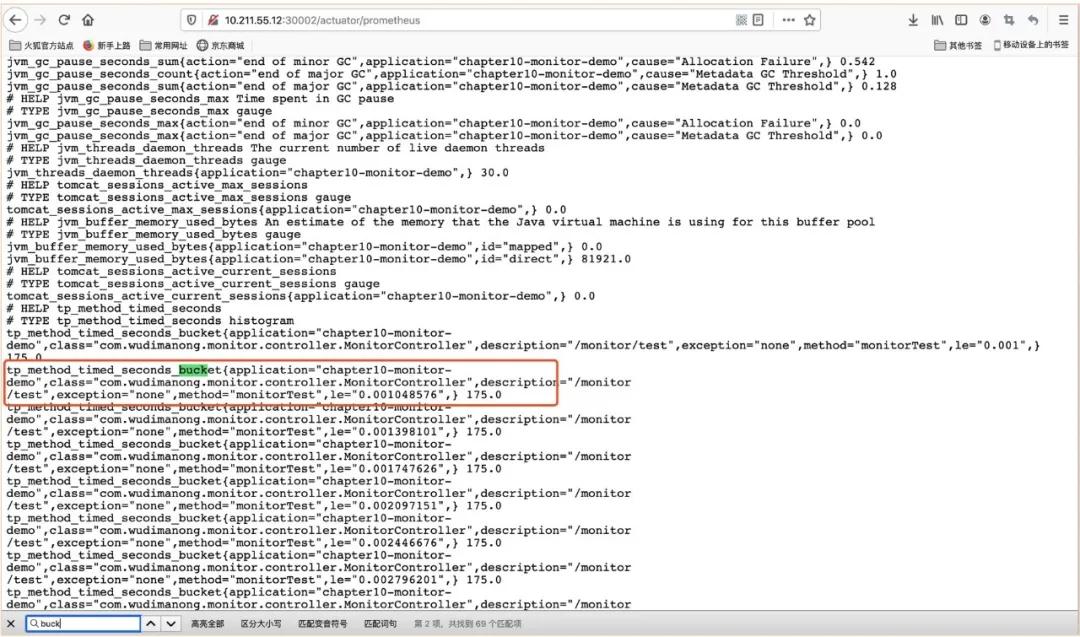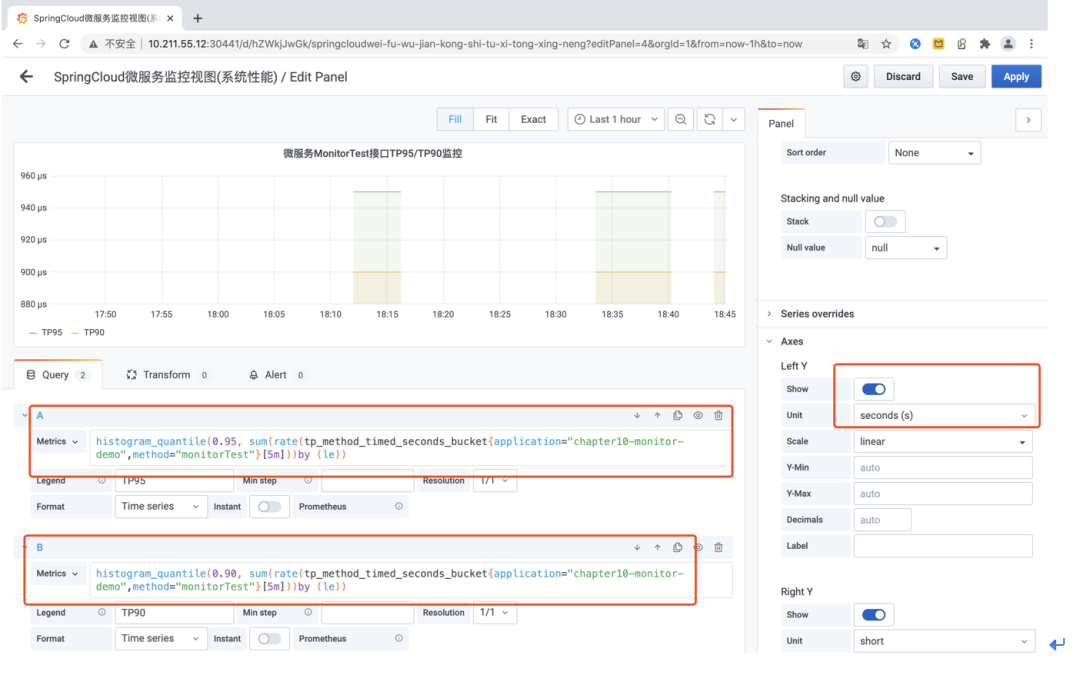如何優(yōu)雅地自定義Prometheus監(jiān)控指標(biāo)
本文轉(zhuǎn)載自微信公眾號(hào)「無(wú)敵碼農(nóng)」,作者無(wú)敵碼農(nóng)。轉(zhuǎn)載本文請(qǐng)聯(lián)系無(wú)敵碼農(nóng)公眾號(hào)。
大家好!我是"無(wú)敵碼農(nóng)",今天要和大家分享的是在實(shí)際工作中“如何優(yōu)雅地自定義Prometheus監(jiān)控指標(biāo)”!目前大部分使用Spring Boot構(gòu)建微服務(wù)體系的公司,大都在使用Prometheus來(lái)構(gòu)建微服務(wù)的度量指標(biāo)(Metrics)類監(jiān)控系統(tǒng)。而一般做法是通過(guò)在微服務(wù)應(yīng)用中集成Prometheus指標(biāo)采集SDK,從而使得Spring Boot暴露相關(guān)Metrics采集端點(diǎn)來(lái)實(shí)現(xiàn)。
但一般來(lái)說(shuō),Spring Boot默認(rèn)暴露的Metrics數(shù)量及類型是有限的,如果想要建立針對(duì)微服務(wù)應(yīng)用更豐富的監(jiān)控維度(例如TP90/TP99分位值指標(biāo)之類),那么還需要我們?cè)赟pring Boot默認(rèn)已經(jīng)打開(kāi)的Metrics基礎(chǔ)之上,配置Prometheus類庫(kù)(micrometer-registry-prometheus)所提供的其他指標(biāo)類型。
但怎么樣才能在Spring Boot框架中以更優(yōu)雅地方式實(shí)現(xiàn)呢?難道需要在業(yè)務(wù)代碼中編寫(xiě)各種自定義監(jiān)控指標(biāo)代碼的暴露邏輯嗎?接下來(lái)的內(nèi)容我們將通過(guò)@注解+AOP的方式來(lái)演示如何以更加優(yōu)雅的方式來(lái)實(shí)現(xiàn)Prometheus監(jiān)控指標(biāo)的自定義!
自定義監(jiān)控指標(biāo)配置注解
需要說(shuō)明的是在Spring Boot應(yīng)用中,對(duì)程序運(yùn)行信息的收集(如指標(biāo)、日志),比較常用的方法是通過(guò)Spring的AOP代理攔截來(lái)實(shí)現(xiàn),但這種攔截程序運(yùn)行過(guò)程的邏輯多少會(huì)損耗點(diǎn)系統(tǒng)性能,因此在自定義Prometheus監(jiān)控指標(biāo)的過(guò)程中,可以將是否上報(bào)指標(biāo)的選擇權(quán)交給開(kāi)發(fā)人員,而從易用性角度來(lái)說(shuō),可以通過(guò)注解的方式實(shí)現(xiàn)。例如:
- package com.wudimanong.monitor.metrics.annotation;
- import java.lang.annotation.ElementType;
- import java.lang.annotation.Inherited;
- import java.lang.annotation.Retention;
- import java.lang.annotation.RetentionPolicy;
- import java.lang.annotation.Target;
- @Target({ElementType.METHOD})
- @Retention(RetentionPolicy.RUNTIME)
- @Inherited
- public @interface Tp {
- String description() default "";
- }
如上所示代碼,我們定義了一個(gè)用于標(biāo)注上報(bào)計(jì)時(shí)器指標(biāo)類型的注解,如果想統(tǒng)計(jì)接口的想TP90、TP99這樣的分位值指標(biāo),那么就可以通過(guò)該注解標(biāo)注。除此之外,還可以定義上報(bào)其他指標(biāo)類型的注解,例如:
- package com.wudimanong.monitor.metrics.annotation;
- import java.lang.annotation.ElementType;
- import java.lang.annotation.Inherited;
- import java.lang.annotation.Retention;
- import java.lang.annotation.RetentionPolicy;
- import java.lang.annotation.Target;
- @Target({ElementType.METHOD})
- @Retention(RetentionPolicy.RUNTIME)
- @Inherited
- public @interface Count {
- String description() default "";
- }
如上所示,我們定義了一個(gè)用于上報(bào)計(jì)數(shù)器類型指標(biāo)的注解!如果要統(tǒng)計(jì)接口的平均響應(yīng)時(shí)間、接口的請(qǐng)求量之類的指標(biāo),那么可以通過(guò)該注解標(biāo)注!
而如果覺(jué)得分別定義不同指標(biāo)類型的注解比較麻煩,對(duì)于某些接口上述各種指標(biāo)類型都希望上報(bào)到Prometheus,那么也可以定義一個(gè)通用注解,用于同時(shí)上報(bào)多個(gè)指標(biāo)類型,例如:
- package com.wudimanong.monitor.metrics.annotation;
- import java.lang.annotation.ElementType;
- import java.lang.annotation.Inherited;
- import java.lang.annotation.Retention;
- import java.lang.annotation.RetentionPolicy;
- import java.lang.annotation.Target;
- @Target({ElementType.METHOD})
- @Retention(RetentionPolicy.RUNTIME)
- @Inherited
- public @interface Monitor {
- String description() default "";
- }
總之,無(wú)論是分開(kāi)定義特定指標(biāo)注解還是定義一個(gè)通用的指標(biāo)注解,其目標(biāo)都是希望以更靈活的方式來(lái)擴(kuò)展Spring Boot微服務(wù)應(yīng)用的監(jiān)控指標(biāo)類型。
自定義監(jiān)控指標(biāo)注解AOP代理邏輯實(shí)現(xiàn)
上面我們靈活定義了上報(bào)不同指標(biāo)類型的注解,而上述注解的具體實(shí)現(xiàn)邏輯,可以通過(guò)定義一個(gè)通用的AOP代理類來(lái)實(shí)現(xiàn),具體實(shí)現(xiàn)代碼如下:
- package com.wudimanong.monitor.metrics.aop;
- import com.wudimanong.monitor.metrics.Metrics;
- import com.wudimanong.monitor.metrics.annotation.Count;
- import com.wudimanong.monitor.metrics.annotation.Monitor;
- import com.wudimanong.monitor.metrics.annotation.Tp;
- import io.micrometer.core.instrument.Counter;
- import io.micrometer.core.instrument.MeterRegistry;
- import io.micrometer.core.instrument.Tag;
- import io.micrometer.core.instrument.Tags;
- import io.micrometer.core.instrument.Timer;
- import java.lang.reflect.Method;
- import java.util.function.Function;
- import org.aspectj.lang.ProceedingJoinPoint;
- import org.aspectj.lang.annotation.Around;
- import org.aspectj.lang.annotation.Aspect;
- import org.aspectj.lang.reflect.MethodSignature;
- import org.springframework.stereotype.Component;
- @Aspect
- @Component
- public class MetricsAspect {
- /**
- * Prometheus指標(biāo)管理
- */
- private MeterRegistry registry;
- private Function<ProceedingJoinPoint, Iterable<Tag>> tagsBasedOnJoinPoint;
- public MetricsAspect(MeterRegistry registry) {
- this.init(registry, pjp -> Tags
- .of(new String[]{"class", pjp.getStaticPart().getSignature().getDeclaringTypeName(), "method",
- pjp.getStaticPart().getSignature().getName()}));
- }
- public void init(MeterRegistry registry, Function<ProceedingJoinPoint, Iterable<Tag>> tagsBasedOnJoinPoint) {
- this.registry = registry;
- this.tagsBasedOnJoinPoint = tagsBasedOnJoinPoint;
- }
- /**
- * 針對(duì)@Tp指標(biāo)配置注解的邏輯實(shí)現(xiàn)
- */
- @Around("@annotation(com.wudimanong.monitor.metrics.annotation.Tp)")
- public Object timedMethod(ProceedingJoinPoint pjp) throws Throwable {
- Method method = ((MethodSignature) pjp.getSignature()).getMethod();
- method = pjp.getTarget().getClass().getMethod(method.getName(), method.getParameterTypes());
- Tp tp = method.getAnnotation(Tp.class);
- Timer.Sample sample = Timer.start(this.registry);
- String exceptionClass = "none";
- try {
- return pjp.proceed();
- } catch (Exception ex) {
- exceptionClass = ex.getClass().getSimpleName();
- throw ex;
- } finally {
- try {
- String finalExceptionClass = exceptionClass;
- //創(chuàng)建定義計(jì)數(shù)器,并設(shè)置指標(biāo)的Tags信息(名稱可以自定義)
- Timer timer = Metrics.newTimer("tp.method.timed",
- builder -> builder.tags(new String[]{"exception", finalExceptionClass})
- .tags(this.tagsBasedOnJoinPoint.apply(pjp)).tag("description", tp.description())
- .publishPercentileHistogram().register(this.registry));
- sample.stop(timer);
- } catch (Exception exception) {
- }
- }
- }
- /**
- * 針對(duì)@Count指標(biāo)配置注解的邏輯實(shí)現(xiàn)
- */
- @Around("@annotation(com.wudimanong.monitor.metrics.annotation.Count)")
- public Object countMethod(ProceedingJoinPoint pjp) throws Throwable {
- Method method = ((MethodSignature) pjp.getSignature()).getMethod();
- method = pjp.getTarget().getClass().getMethod(method.getName(), method.getParameterTypes());
- Count count = method.getAnnotation(Count.class);
- String exceptionClass = "none";
- try {
- return pjp.proceed();
- } catch (Exception ex) {
- exceptionClass = ex.getClass().getSimpleName();
- throw ex;
- } finally {
- try {
- String finalExceptionClass = exceptionClass;
- //創(chuàng)建定義計(jì)數(shù)器,并設(shè)置指標(biāo)的Tags信息(名稱可以自定義)
- Counter counter = Metrics.newCounter("count.method.counted",
- builder -> builder.tags(new String[]{"exception", finalExceptionClass})
- .tags(this.tagsBasedOnJoinPoint.apply(pjp)).tag("description", count.description())
- .register(this.registry));
- counter.increment();
- } catch (Exception exception) {
- }
- }
- }
- /**
- * 針對(duì)@Monitor通用指標(biāo)配置注解的邏輯實(shí)現(xiàn)
- */
- @Around("@annotation(com.wudimanong.monitor.metrics.annotation.Monitor)")
- public Object monitorMethod(ProceedingJoinPoint pjp) throws Throwable {
- Method method = ((MethodSignature) pjp.getSignature()).getMethod();
- method = pjp.getTarget().getClass().getMethod(method.getName(), method.getParameterTypes());
- Monitor monitor = method.getAnnotation(Monitor.class);
- String exceptionClass = "none";
- try {
- return pjp.proceed();
- } catch (Exception ex) {
- exceptionClass = ex.getClass().getSimpleName();
- throw ex;
- } finally {
- try {
- String finalExceptionClass = exceptionClass;
- //計(jì)時(shí)器Metric
- Timer timer = Metrics.newTimer("tp.method.timed",
- builder -> builder.tags(new String[]{"exception", finalExceptionClass})
- .tags(this.tagsBasedOnJoinPoint.apply(pjp)).tag("description", monitor.description())
- .publishPercentileHistogram().register(this.registry));
- Timer.Sample sample = Timer.start(this.registry);
- sample.stop(timer);
- //計(jì)數(shù)器Metric
- Counter counter = Metrics.newCounter("count.method.counted",
- builder -> builder.tags(new String[]{"exception", finalExceptionClass})
- .tags(this.tagsBasedOnJoinPoint.apply(pjp)).tag("description", monitor.description())
- .register(this.registry));
- counter.increment();
- } catch (Exception exception) {
- }
- }
- }
- }
上述代碼完整的實(shí)現(xiàn)了前面我們定義的指標(biāo)配置注解的邏輯,其中針對(duì)@Monitor注解的邏輯就是@Tp和@Count注解邏輯的整合。如果還需要定義其他指標(biāo)類型,可以在此基礎(chǔ)上繼續(xù)擴(kuò)展!
需要注意,在上述邏輯實(shí)現(xiàn)中對(duì)“Timer”及“Counter”等指標(biāo)類型的構(gòu)建這里并沒(méi)有直接使用“micrometer-registry-prometheus”依賴包中的構(gòu)建對(duì)象,而是通過(guò)自定義的Metrics.newTimer()這樣的方式實(shí)現(xiàn),其主要用意是希望以更簡(jiǎn)潔、靈活的方式去實(shí)現(xiàn)指標(biāo)的上報(bào),其代碼定義如下:
- package com.wudimanong.monitor.metrics;
- import io.micrometer.core.instrument.Counter;
- import io.micrometer.core.instrument.Counter.Builder;
- import io.micrometer.core.instrument.DistributionSummary;
- import io.micrometer.core.instrument.Gauge;
- import io.micrometer.core.instrument.MeterRegistry;
- import io.micrometer.core.instrument.Timer;
- import io.micrometer.core.lang.NonNull;
- import java.util.function.Consumer;
- import java.util.function.Supplier;
- import org.springframework.beans.BeansException;
- import org.springframework.context.ApplicationContext;
- import org.springframework.context.ApplicationContextAware;
- public class Metrics implements ApplicationContextAware {
- private static ApplicationContext context;
- @Override
- public void setApplicationContext(@NonNull ApplicationContext applicationContext) throws BeansException {
- context = applicationContext;
- }
- public static ApplicationContext getContext() {
- return context;
- }
- public static Counter newCounter(String name, Consumer<Builder> consumer) {
- MeterRegistry meterRegistry = context.getBean(MeterRegistry.class);
- return new CounterBuilder(meterRegistry, name, consumer).build();
- }
- public static Timer newTimer(String name, Consumer<Timer.Builder> consumer) {
- return new TimerBuilder(context.getBean(MeterRegistry.class), name, consumer).build();
- }
- }
上述代碼通過(guò)接入Spring容器上下文,獲取了MeterRegistry實(shí)例,并以此來(lái)構(gòu)建像Counter、Timer這樣的指標(biāo)類型對(duì)象。而這里之所以將獲取方法定義為靜態(tài)的,主要是便于在業(yè)務(wù)代碼中進(jìn)行引用!
而在上述代碼中涉及的CounterBuilder、TimerBuilder構(gòu)造器代碼定義分別如下:
- package com.wudimanong.monitor.metrics;
- import io.micrometer.core.instrument.Counter;
- import io.micrometer.core.instrument.Counter.Builder;
- import io.micrometer.core.instrument.MeterRegistry;
- import java.util.function.Consumer;
- public class CounterBuilder {
- private final MeterRegistry meterRegistry;
- private Counter.Builder builder;
- private Consumer<Builder> consumer;
- public CounterBuilder(MeterRegistry meterRegistry, String name, Consumer<Counter.Builder> consumer) {
- this.builder = Counter.builder(name);
- this.meterRegistry = meterRegistry;
- this.consumer = consumer;
- }
- public Counter build() {
- consumer.accept(builder);
- return builder.register(meterRegistry);
- }
- }
上述代碼為CounterBuilder構(gòu)造器代碼!TimerBuilder構(gòu)造器代碼如下:
- package com.wudimanong.monitor.metrics;
- import io.micrometer.core.instrument.MeterRegistry;
- import io.micrometer.core.instrument.Timer;
- import io.micrometer.core.instrument.Timer.Builder;
- import java.util.function.Consumer;
- public class TimerBuilder {
- private final MeterRegistry meterRegistry;
- private Timer.Builder builder;
- private Consumer<Builder> consumer;
- public TimerBuilder(MeterRegistry meterRegistry, String name, Consumer<Timer.Builder> consumer) {
- this.builder = Timer.builder(name);
- this.meterRegistry = meterRegistry;
- this.consumer = consumer;
- }
- public Timer build() {
- this.consumer.accept(builder);
- return builder.register(meterRegistry);
- }
- }
之所以還特地將構(gòu)造器代碼單獨(dú)定義,主要是從代碼的優(yōu)雅性考慮!如果涉及其他指標(biāo)類型的構(gòu)造,也可以通過(guò)類似的方法進(jìn)行擴(kuò)展!
自定義指標(biāo)注解配置類
在上述代碼中我們已經(jīng)定義了幾個(gè)自定義指標(biāo)注解及其實(shí)現(xiàn)邏輯代碼,為了使其在Spring Boot環(huán)境中運(yùn)行,還需要編寫(xiě)如下配置類,代碼如下:
- package com.wudimanong.monitor.metrics.config;
- import com.wudimanong.monitor.metrics.Metrics;
- import io.micrometer.core.instrument.MeterRegistry;
- import org.springframework.boot.actuate.autoconfigure.metrics.MeterRegistryCustomizer;
- import org.springframework.boot.autoconfigure.condition.ConditionalOnMissingBean;
- import org.springframework.context.annotation.Bean;
- import org.springframework.context.annotation.Configuration;
- import org.springframework.core.env.Environment;
- @Configuration
- public class CustomMetricsAutoConfiguration {
- @Bean
- @ConditionalOnMissingBean
- public MeterRegistryCustomizer<MeterRegistry> meterRegistryCustomizer(Environment environment) {
- return registry -> {
- registry.config()
- .commonTags("application", environment.getProperty("spring.application.name"));
- };
- }
- @Bean
- @ConditionalOnMissingBean
- public Metrics metrics() {
- return new Metrics();
- }
- }
上述配置代碼主要是約定了上報(bào)Prometheus指標(biāo)信息中所攜帶的應(yīng)用名稱,并對(duì)自定義了Metrics類進(jìn)行了Bean配置!
業(yè)務(wù)代碼的使用方式及效果
接下來(lái)我們演示在業(yè)務(wù)代碼中如果要上報(bào)Prometheus監(jiān)控指標(biāo)應(yīng)該怎么寫(xiě),具體如下:
- package com.wudimanong.monitor.controller;
- import com.wudimanong.monitor.metrics.annotation.Count;
- import com.wudimanong.monitor.metrics.annotation.Monitor;
- import com.wudimanong.monitor.metrics.annotation.Tp;
- import com.wudimanong.monitor.service.MonitorService;
- import org.springframework.beans.factory.annotation.Autowired;
- import org.springframework.web.bind.annotation.GetMapping;
- import org.springframework.web.bind.annotation.RequestMapping;
- import org.springframework.web.bind.annotation.RequestParam;
- import org.springframework.web.bind.annotation.RestController;
- @RestController
- @RequestMapping("/monitor")
- public class MonitorController {
- @Autowired
- private MonitorService monitorServiceImpl;
- //監(jiān)控指標(biāo)注解使用
- //@Tp(description = "/monitor/test")
- //@Count(description = "/monitor/test")
- @Monitor(description = "/monitor/test")
- @GetMapping("/test")
- public String monitorTest(@RequestParam("name") String name) {
- monitorServiceImpl.monitorTest(name);
- return "監(jiān)控示范工程測(cè)試接口返回->OK!";
- }
- }
如上述代碼所示,在實(shí)際的業(yè)務(wù)編程中就可以比較簡(jiǎn)單的通過(guò)注解來(lái)配置接口所上傳的Prometheus監(jiān)控指標(biāo)了!此時(shí)在本地啟動(dòng)程序,可以通過(guò)訪問(wèn)微服務(wù)應(yīng)用的“/actuator/prometheus”指標(biāo)采集端點(diǎn)來(lái)查看相關(guān)指標(biāo),如下圖所示:
有了這些自定義上報(bào)的監(jiān)控指標(biāo),那么Promethues在采集后,我們就可以通過(guò)像Grafana這樣的可視化工具,來(lái)構(gòu)建起多維度界面友好地監(jiān)控視圖了,例如以TP90/TP99為例:
如上所示,在Grafana中可以同時(shí)定義多個(gè)PromeQL來(lái)定于不同的監(jiān)控指標(biāo)信息,這里我們分別通過(guò)Prometheus所提供的“histogram_quantile”函數(shù)統(tǒng)計(jì)了接口方法“monitorTest”的TP90及TP95分位值!而所使用的指標(biāo)就是自定義的“tp_method_timed_xx”指標(biāo)類型!
后記
以上就是我最近在工作中封裝的一組關(guān)于Prometheus自定義監(jiān)控指標(biāo)的SDK代碼,在實(shí)際工作中可以將其封住為Spring Boot Starter依賴的形式,從而更好地被Spring Boot項(xiàng)目集成!至此我已經(jīng)毫無(wú)保留的將最近兩天的工作成果分享給大家了,也希望各位老鐵可以多多點(diǎn)贊支持,多多轉(zhuǎn)發(fā)傳播!





































